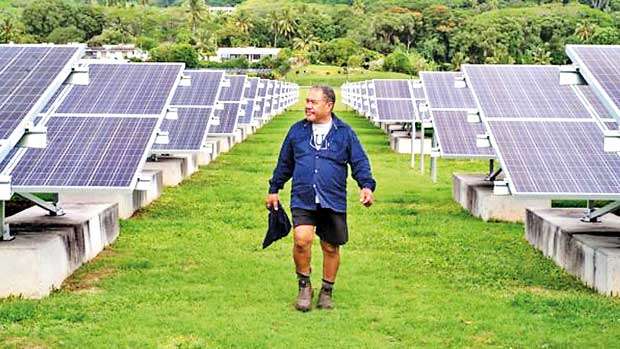10 May 2018 - {{hitsCtrl.values.hits}}

 The relative abundance and modular nature of solar and wind are driving the shift to renewables.
The relative abundance and modular nature of solar and wind are driving the shift to renewables.
Multiple trends are driving the transformation of global energy systems. One of them is electricity networks, including “the digitization of everything and the electrification of everything”, decentralization, decarbonization and deregulation.
Accelerated deployment and the rapidly falling cost of solar and wind power, energy storage, electric vehicles, smart grid technology and more broadly the Internet of things, can all facilitate the growth of digital “exoskeletons” around electricity networks and other energy systems. This increases network resilience, while creating opportunities for new business models and operations.
Technologies are evolving at exponential rates but policy, planning and investment decisions continue to evolve in a linear fashion. Disruption is inevitable but can the transformation be managed?
Below are a few observations from a recent high-level seminar on the future of energy systems organised by the Asian Development Bank (ADB). A key outcome of the discussions was identifying comparative and competitive advantages of the ADB member countries with respect to mega-trends and constraints and how relevant technical and financial support can be articulated and delivered in a “future-proof” manner.
1. Same word, different meanings
The clean energy future is distributed energy mini-grids, powered mostly by renewables and enabled by energy storage. It’s the obvious solution for islands and remote mountainous areas, which suffer from the tyranny of distance, as well as for developing countries faced with inherent dis-economies of scale.
In developed countries, mini-grids are also being constructed on centralized grids, with capability to operate in “island” mode. Sweden is already experimenting with a mini-grid of this type that can also provide a load-balancing function for the centralized grid.
“Electrification” has multiple meanings. In developing countries, it usually means achieving universal access to electricity, while in developed countries it is about electrification of industrial processes, transportation systems, cooking and heating, to move away from carbon-intensive systems.
Such cases imply that developing countries have great potential to leapfrog from meeting basic needs but also set themselves in a “future-ready” mode to embrace the next generation of technology. In this context, North-South cooperation is important to facilitate leapfrogging.
2. Reinventing industries in a carbon-constrained world
As the costs of solar, wind and storage systems continue to decline, decarbonization is the “new normal” in energy development. Achieving 100 percent renewable electricity appears feasible in many developing countries but writing off the legacy costs of fossil fuel systems imposes economic costs and may not be practical in the short term.
There are opportunities for re-invention: the conventional coal-fired power plant can be transformed into a factory that produces electricity, heat, sulfuric acid, nitric acid and carbon dioxide as industrial feedstock. This industrial cleaner production approach to carbon capture and reuse is expected to become a global market of US $ 1 trillion by 2030.
3. Value propositions of energy storage
The relative abundance of solar and wind resources and the modular nature of solar and wind energy systems are driving the shift to renewables. However, the variable output of these systems requires energy storage to fully realize the economic value of renewables.
Lithium-ion batteries are proving themselves for short-term grid stability applications like frequency control but a new family of technologies must be commercialized for time-shifting of energy (shifting energy output from periods of generation surplus to times when generation is in deficit).
Although the lithium-ion market is growing rapidly, driven by power and transport applications, the technology is likely to be superseded by something better (the race is on and it is far from over). Redox flow batteries and hydrogen may be the ultimate winners in bulk energy and seasonal time-shifting.
Floating solar in existing hydropower reservoirs provides an opportunity for daily time-shifting, with hydro-generation reduced during the day as solar output ramps up. This “virtual pumped storage” can be deployed at much lower cost than conventional pumped hydro.
Virtual power plants are being deployed at scale and will likely play a key role in the future as the enabling technologies of storage and peer-to-peer trading are proven. Electricity can’t be stored, but it can be converted to something useful, such as power-to-gas or power-to-hydrogen for transport fuel, and power-to-pure water via atmospheric water generators and desalination plants.
4. Managing the transition
Digitization is unstoppable and in electricity networks it is critical for monitoring, control and dispatch, trading and storage. As noted above, distributed mini-grids are the future and the enabling services are energy storage and digital management systems.
However, the pace of transition will be different in each country, so watch out for changes in mindset, lifestyle and consumption.
As shifting from legacy fossil fuel systems to 21st century systems without making people pay more for energy services is critical, ADB will continue to provide platforms for learning-by-doing and knowledge exchange, including North-South, South-South, and South-North cooperation.
(Yongping Zhai is Technical Advisor (Energy), Sustainable Development and Climate Change Department, the Asian Development Bank)
18 Nov 2024 4 hours ago
18 Nov 2024 5 hours ago
18 Nov 2024 5 hours ago
18 Nov 2024 5 hours ago
18 Nov 2024 5 hours ago